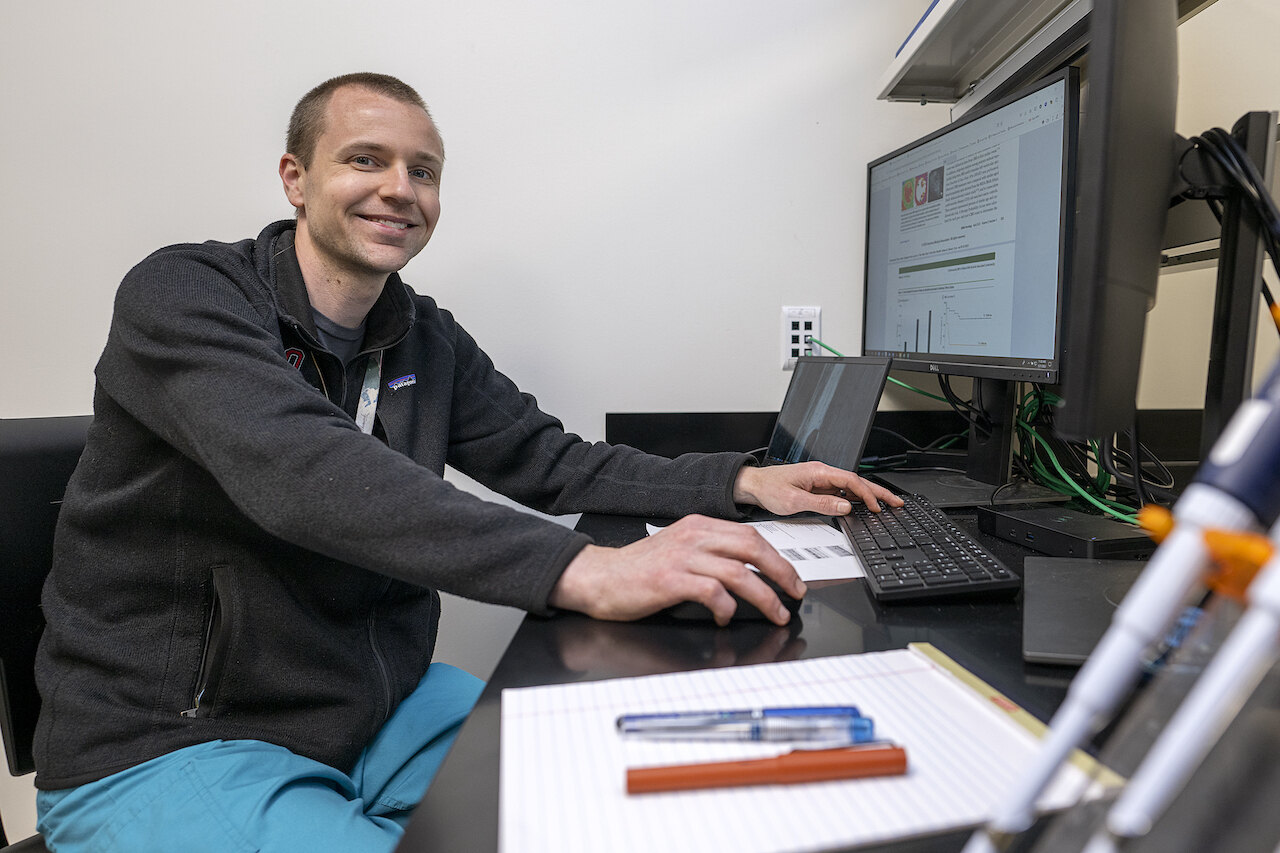Master of Public Health in Biostatistics

May 15, 2026
August 25, 2026
Prepare to lead and innovate in the field of public health
Advance your career in applied public health practice with Ohio State’s online Master of Public Health in Biostatistics. Designed for working professionals, you’ll gain in-depth knowledge of biostatistics, with 23 out of the required 42 credit hours dedicated specifically to your chosen field. Through 100% online coursework, you’ll learn from the same world-renowned faculty who teach on campus, ensuring you receive a top-tier education tailored to your needs.
Why choose Ohio State’s online MPH in Biostatistics?
What sets this program apart is its experiential learning focus. You’ll engage in an interactive research project and an applied practice experience that allows you to apply what you’ve learned in real-world settings. Throughout your journey, a dedicated faculty advisor will guide you, offering personalized support and helping you achieve your professional goals.

Frequently Asked Questions
The Master of Public Health in Biostatistics is a flexible online program, with full-time and part-time options available for degree-seeking students. You can complete the 42 credit hours in as little as two years or take up to five years to earn your MPH degree.
Courses are offered online in highly interactive formats, including group conversations, presentations, discussions, and lectures. You will connect with peers and instructors through Ohio State’s learning management system, CarmenCanvas, giving you the flexibility to complete assignments while maintaining dynamic connections with your learning community.
An MPA prepares individuals for leadership roles in government and nonprofit organizations. The curriculum emphasizes public policy, budgeting, and organizational management. Graduates often find careers in government agencies, consulting firms, nonprofits or advocacy groups. Conversely, an MPH focuses on improving population health through prevention and disease control. Core coursework includes epidemiology, biostatistics, and health education. MPH graduates frequently work in public health departments, healthcare organizations, non-profit health organizations or research institutions.
While you won’t need to go to campus, some courses may be synchronous, which means there are set meeting times to meet online; however, most courses are asynchronous. Additionally, you’ll complete the Applied Practice Experience (APE), an integral part of the MPH program that allows you to apply what you have learned in the classroom in a public health setting. You’ll work closely with the college to find an experience and then with a public health professional to gain valuable public health experience to meet educational and professional growth goals.
You’ll receive one-on-one guidance from a faculty advisor throughout the online MPH program. You’ll also receive support from the College of Public Health’s student services team, and you’ll have access to various Ohio State resources to help you succeed academically, provide career mentorship, and develop your professional interests.
Related Content
Related Content

What can you do with a Master of Public Health?

How to choose the right Master of Public Health specialization

How to balance career, family, and school through online learning
Related Programs
In addition to the online MPH in Biostatistics, Ohio State offers a range of online and on-campus public health degrees and certificates—giving you the flexibility to choose a program that aligns with your career goals and lifestyle. All graduate programs require a bachelor’s degree for admission.
Ohio State’s fully online Master of Public Health – Program for Experienced Professionals (MPH-PEP). With its tailored curriculum, you’ll gain essential skills in leadership, strategy, and planning to support health organizations.
Ohio State’s online 14-credit-hour Biostatistics Graduate Certificate equips you to effectively analyze data, apply statistical methods, and contribute to public health research.
The Ohio State University College of Public Health offers several campus-based MPH specializations, including biomedical informatics, environmental health sciences, epidemiology, health behavior and health promotion, and veterinary public health.
Academic Calendar
Be sure to submit your application by May 15 to be considered for the upcoming term. Classes begin in late August, so you’ll have time to prepare before the semester kicks off. Check this page regularly for updated deadlines and start dates for future terms.
Academic Calendar
Be sure to submit your application by May 15 to be considered for the upcoming term. Classes begin in late August, so you’ll have time to prepare before the semester kicks off. Check this page regularly for updated deadlines and start dates for future terms.
Admission Criteria
No GRE is required for this program. Applicants must apply through the Schools of Public Health Application Service (SOPHAS), and admissions decisions are made on a rolling basis. A completed application includes the following:
-
Completed SOPHAS application
-
Official transcripts from any previous or current college coursework taken within the U.S.
-
Completion of an undergraduate or graduate level stats course with a B or higher is preferred for a successful applicant
-
Three letters of recommendation
-
Personal statement
-
Resume or CV
-
Ohio State University Supplemental Application – this will be emailed to you from Ohio State one to two weeks after your centralized application reaches “Verified” status
Applications are reviewed on a rolling basis, subject to available space, and evaluated based on leadership experience, perseverance, academic history, program fit, and commitment to equity in public health.

The Ohio State University participates in the State Authorization Reciprocity Agreements (SARA).
SARA is a national initiative that increases student access to distance education courses and programs while maintaining compliance with state regulations. Institutions participating in SARA can offer educational opportunities in all 49 SARA member states, the District of Columbia, the U.S. Virgin Islands and Puerto Rico without seeking individual approval in each state.
California is not a SARA member state, however, OSU may offer online courses and programs to students located in California under the California Private Post-Secondary Act of 2009.
The Application Process
Once you understand your program’s admission criteria, please note the application deadline. You’ll need a quiet space and a variety of materials for your application. To learn more, please see our Admissions page for the full process. Ready to Apply? Find your application here.
Career Outlook
Elevate your expertise in health data analysis and research. Ohio State’s online MPH in Biostatistics equips you to make critical decisions in public health policy and clinical practice, using your advanced skills in statistical analysis to develop meaningful research.
Top Occupations by Median Income
What They Do
Conduct research using bioinformatics theory and methods in areas such as pharmaceuticals, medical technology, biotechnology, computational biology, proteomics, computer information science, biology and medical informatics. May design databases and develop algorithms for processing and analyzing genomic information, or other biological information.
Work Activities
Develop new software applications or customize existing applications to meet specific scientific project needs. Communicate research results through conference presentations, scientific publications, or project reports. Create novel computational approaches and analytical tools as required by research goals.
Wage Range
- Entry Level: $54,500
- Mid Level: $93,330
- Senior Level: $159,780
Job Outlook
Bright
Projected Growth
5.6%
Related Careers
- Bioinformatics Technicians
- Biostatisticians
- Data Scientists
- Geneticists
- Molecular and Cellular Biologists
Job Sectors
- Biology
- Computers and Electronics
- Mathematics
- English Language
- Chemistry
What They Do
Apply principles and methods of bioinformatics to assist scientists in areas such as pharmaceuticals, medical technology, biotechnology, computational biology, proteomics, computer information science, biology and medical informatics. Apply bioinformatics tools to visualize, analyze, manipulate or interpret molecular data. May build and maintain databases for processing and analyzing genomic or other biological information.
Work Activities
Analyze or manipulate bioinformatics data using software packages, statistical applications, or data mining techniques. Extend existing software programs, web-based interactive tools, or database queries as sequence management and analysis needs evolve. Maintain awareness of new and emerging computational methods and technologies.
Wage Range
- Entry Level: $40,330
- Mid Level: $71,490
- Senior Level: $154,140
Job Outlook
Bright
Projected Growth
6.9%
Related Careers
- Biological Technicians
- Data Scientists
- Database Architects
- Health Information Technologists and Medical Registrars
- Statistical Assistants
Job Sectors
- Computers and Electronics
- Mathematics
- English Language
- Biology
What They Do
Develop and apply biostatistical theory and methods to the study of life sciences.
Work Activities
Draw conclusions or make predictions, based on data summaries or statistical analyses. Analyze clinical or survey data, using statistical approaches such as longitudinal analysis, mixed-effect modeling, logistic regression analyses, and model-building techniques. Write detailed analysis plans and descriptions of analyses and findings for research protocols or reports.
Wage Range
- Entry Level: $60,390
- Mid Level: $103,300
- Senior Level: $170,700
Job Outlook
Bright
Projected Growth
11.8%
Related Careers
- Bioinformatics Scientists
- Bioinformatics Technicians
- Clinical Data Managers
- Data Scientists
- Statisticians
Job Sectors
- Mathematics
- English Language
- Computers and Electronics
- Medicine and Dentistry
What They Do
Develop and implement a set of techniques or analytics applications to transform raw data into meaningful information using data-oriented programming languages and visualization software. Apply data mining, data modeling, natural language processing, and machine learning to extract and analyze information from large structured and unstructured datasets. Visualize, interpret, and report data findings. May create dynamic data reports.
Work Activities
Analyze, manipulate, or process large sets of data using statistical software. Apply feature selection algorithms to models predicting outcomes of interest, such as sales, attrition, and healthcare use. Apply sampling techniques to determine groups to be surveyed or use complete enumeration methods.
Wage Range
- Entry Level: $63,650
- Mid Level: $112,590
- Senior Level: $194,410
Job Outlook
Bright
Projected Growth
36%
Related Careers
- Bioinformatics Technicians
- Financial Quantitative Analysts
- Operations Research Analysts
- Statistical Assistants
- Statisticians
What They Do
Develop or apply mathematical or statistical theory and methods to collect, organize, interpret, and summarize numerical data to provide usable information. May specialize in fields such as biostatistics, agricultural statistics, business statistics, or economic statistics. Includes mathematical and survey statisticians.
Work Activities
Analyze and interpret statistical data to identify significant differences in relationships among sources of information. Evaluate the statistical methods and procedures used to obtain data to ensure validity, applicability, efficiency, and accuracy. Report results of statistical analyses, including information in the form of graphs, charts, and tables.
Wage Range
- Entry Level: $60,390
- Mid Level: $103,300
- Senior Level: $170,700
Job Outlook
Bright
Projected Growth
11.8%
Related Careers
- Bioinformatics Scientists
- Biostatisticians
- Clinical Data Managers
- Data Scientists
- Mathematicians
Job Sectors
- Mathematics
- Computers and Electronics
- English Language
What They Do
Plan, develop, or conduct surveys. May analyze and interpret the meaning of survey data, determine survey objectives, or suggest or test question wording. Includes social scientists who primarily design questionnaires or supervise survey teams.
Work Activities
Review, classify, and record survey data in preparation for computer analysis. Monitor and evaluate survey progress and performance, using sample disposition reports and response rate calculations. Produce documentation of the questionnaire development process, data collection methods, sampling designs, and decisions related to sample statistical weighting.
Wage Range
- Entry Level: $36,950
- Mid Level: $63,380
- Senior Level: $118,730
Job Outlook
Below Average
Projected Growth
-0.2%
Related Careers
- Data Scientists
- Management Analysts
- Social Science Research Assistants
- Statistical Assistants
- Statisticians
Job Sectors
- English Language
- Mathematics
- Customer and Personal Service
- Administration and Management
- Computers and Electronics
National occupational information in Ohio State Online’s Career Outlook tool is sourced from O*NET Online and the U.S. Bureau of Labor Statistics (BLS). The median annual wage displayed to the right of each occupational title above is based on the BLS Employment Projections program. Outlook and percent change indicate projected growth or decline over the next 10 years.
Curriculum
Through 100% online coursework, you’ll expand on foundational public health curriculum with specialized courses in biostatistics, public health informatics and statistical computing software.
Foundational MPH Courses
The biostatistics-focused master’s program builds on the College of Public Health’s foundational MPH curriculum and competencies, which comprise 12 of 42 credit hours.
Fundamentals of biostatistics and epidemiology for MPH students: Will cover core knowledge areas in quantitative data analysis, morbidity, mortality, and risk assessment to understand population health.
Explores the values, history and essential services of the US public health system and the foundations of the social and environmental determinants of health, including the impact of racism, poverty and other structural inequalities.
Addresses the methodology, conceptual frameworks, and strategies for planning and evaluating public health programs.
Examines the organization, delivery and payment of healthcare services in the US and across the world; the framework for organizing the presentation and use of information concerning the effect of environmental conditions on health status.
Required Specialization Courses
Ohio State’s online Master of Public Health degree includes 23 credit hours required for the Biostatistics specialization.
Examines ethical challenges related to research design, data collection, data integrity and stewardship, data analysis and interpretation, and data reporting in the conduct of public health and biomedical research. Through presentation of historical and current case studies we discuss ethical concerns commonly faced by biostatisticians and provide tools to address future quandaries.
Applied biostatistical methods with an emphasis on regression methods commonly used in the health sciences. The focus is on linear regression and ANOVA. Integrated with use of computer statistical packages.
Regression modeling for public health, including models for binary outcomes, count outcomes, survival/censored outcomes, and data collected from complex survey designs.
Design, monitoring, and analysis of clinical trials including protocol development, randomization schemes, sample size methods, and ethical issues.
Basic biomedical research methodologies; collaborate with biomedical researchers to design experiments and plan analyses; protocol preparation; professional skills development; statistical report preparation, and writing analytical code for ensuring scientific rigor and reproducibility of results.
Provides an in‐depth analysis of a specific question to which genomic methods are applied. Intersperses experimental methods and statistical analysis of biological data. Some experience with programming is recommended.
Other 7000 level PUBHBIO courses may be substituted for this course with advisor approval in advance of registering.
This is an introduction course to the commonly used statistical methods for causal inference. The course starts with potential outcome framework as the conceptual foundation for inferring causality.
Other 7000 level PUBHBIO courses may be substituted for this course with advisor approval in advance of registering.
Statistical models and methods for the analysis of data arising from longitudinal studies with repeated measurements on subjects over time.
Other 7000 level PUBHBIO courses may be substituted for this course with advisor approval in advance of registering.
Introduction to the emerging and interdisciplinary field of public health informatics. This course will highlight the history, current and future use of informatics in the public health settings, and give students an understanding of the role and broad application of informatics to promoting health and preventing disease.
Statistical Computing Courses
Select one course to satisfy the two credit hours of statistical computing required for the Master of Public Health in Biostatistics.
Introduces underlying concepts of the R programming language and R package ecosystem for manipulation, visualization, and modeling of data, and for communicating the results of and enabling replication of their analyses.
The basic statistical procedures covered will be illustrated using SAS; covers some of the SAS statistical methods that MPH in biostatistics students require for their own research.
Introduction to programming using SAS software to accomplish public health data management and analysis.
Applied Practice Experience
The applied practice experience (APE) is an integral part of the MPH-PEP. It allows you to apply what you’ve learned in the online classroom in a public health setting. Learn more about the APE from the College of Public Health.
Integrative Learning Experience
Final project for MPH degree to demonstrate synthesis of foundational and concentration competencies applicable to a public health topic.
Understanding Online Course Types
As you research the right online program for you, you likely will come across the terms “asynchronous” and “synchronous.” Learn what these terms mean and how they’re important to consider when understanding how a program will fit into your life.
Learn More

Program Faculty
In Ohio State’s online public health master’s degree in biostatistics, you’ll learn from the same world-renowned faculty who teach on campus, ensuring you receive a top-tier education tailored to your needs.

Kellie Archer
Chair and Professor
“It is essential to conduct research, make evidence-based decisions and derive policies in public health using data from well-designed studies that are appropriately analyzed. Working as a biostatistician at Ohio State allows me to engage in a wide range of applications that are seeking to reduce disease burden and improve public health. Additionally, we are training the next generation of biostatistical researchers to advance methodologies for solving new statistical challenges posed by collecting complex, high-dimensional and high-volume data.”
Rebecca Andridge
Professor
Eben Kenah
Associate Professor
Bo Lu
Professor
Andy Ai
Ni
James Odei
Clinical Associate Professor
Michael Pennell
Professor
Grzegorz A. Rempala
Professor
Patrick Schnell
Associate Professor
Fernanda Schumacher
Assistant Professor
Abby Shoben
Associate Professor
Yuzi Zhang
Assistant ProfessorTestimonials
Learn how Ohio State’s online students use what they have learned in their online coursework and applied it through a variety of professional lenses.

“The MPH in Biostatistics complemented my skills gained in medical training, leading to a positive impact on both my NIH-funded research and evidence-based patient care.”

“Ohio State is a large institution with a lot of possibilities and opportunities. You will meet people who you can connect with and who will connect you with others.”

“This degree will give me more tools to do the work I’m doing with more impact and enable me to better respond to the health needs of the population I serve.”
Tuition Fee Overview
Investing in your future with a higher education degree is one of the best investments you can make for your future success. At Ohio State, we know understanding your program’s cost is an important part of your decision-making process. Below are the tuition fees you can expect with your program.
| Tuition Fees | Per Credit Hour (unless otherwise noted) | Part-Time – Total Cost Per Semester | Full-Time – Total Cost Per Semester |
|---|---|---|---|
| Instructional Fee | $829.75 | $4,978.50 | $6,638.00 |
| General Fee | $32.63 | $195.78 | $261.00 |
| Distance Learning Fee | $100.00 (per semester) | $100.00 | $100.00 |
| Non-Resident Surcharge (if applicable) | $200.00 (per semester) | $200.00 | $200.00 |
Tuition fees are subject to change. The table above serves as a guide and not an official bursar’s bill. Full-Time costs are total tuition costs per semester.
Financial Aid Resource
Financial Aid Resource
Related Articles
Related Articles

How to ask your employer for tuition reimbursement
How to Pay for Your Online Program

Tips for Online Learning from Ohio State Students and Faculty
Get Started
Connect with a knowledgeable Enrollment Advisor who can help answer your questions and explain different aspects of the more than 80 online degrees and certificates offered at Ohio State. They are here to help you on your education journey.



